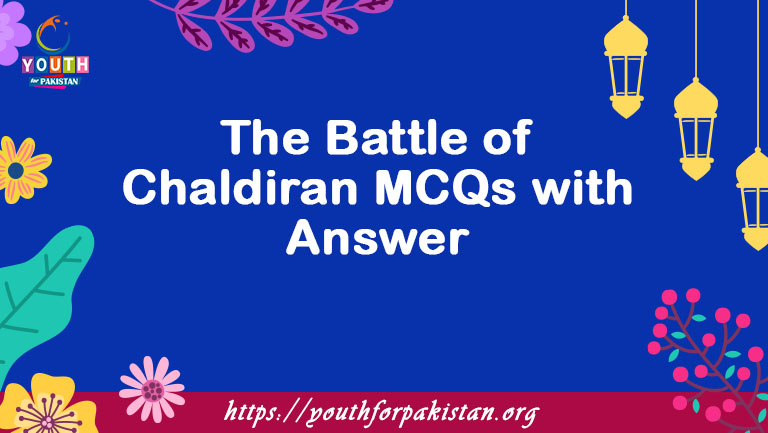The following are The Battle of Chaldiran MCQs with answers related to Islamic Studies. We have arranged the most important and repeated MCQs in all the competitive examinations. The students can clear their concepts for The Battle of Chaldiran MCQs online quiz by attempting these.
The Battle of Chaldiran Online MCQs with Answers
When did The Battle of Chaldiran take place?
A) 1415 AD
B) 610 AD
C) 732 AD
D) 1514 AD
A) Ottoman Empire and Safavid Empire
B) Byzantine Empire and Sassanian Empire
C) Roman Empire and Mughal Empire
D) Mongol Empire and Timurid Empire
A) Suleiman the Magnificent
B) Mehmed the Conqueror
C) Selim I
D) Osman I
A) Ismail I
B) Abbas the Great
C) Shah Jahan
D) Nader Shah
A) Territorial disputes
B) Religious differences
C) Economic rivalry
D) Cultural exchange
A) Sunni
B) Shia
C) Sufi
D) Ibadi
A) Sunni
B) Shia
C) Sufi
D) Ibadi
A) Ottoman victory
B) Safavid victory
C) Stalemate
D) Both sides suffered heavy losses
A) Superior tactics
B) Larger cavalry
C) The use of firearms
D) Strong naval support
A) It marked the end of the Ottoman Empire
B) It solidified the Sunni-Shia divide
C) It led to the establishment of the Mughal Empire
D) It had no lasting impact
A) Suleiman the Magnificent
B) Mehmed the Conqueror
C) Selim I
D) Osman I
A) It led to the collapse of the Safavid Empire
B) It weakened the Safavid Empire but didn’t lead to its downfall
C) It had no significant impact on the Safavid Empire
D) It resulted in the expansion of the Safavid Empire
A) They were not used in the battle
B) They were primarily used by the Safavids
C) They were a significant advantage for the Ottomans
D) Both sides used firearms equally
A) Istanbul
B) Tabriz
C) Baghdad
D) Tehran
A) Suleiman the Magnificent
B) Mehmed the Conqueror
C) Ismail I
D) Selim I
A) The interpretation of the Quran
B) The importance of pilgrimage to Mecca
C) The choice of the rightful caliph
D) The practice of Sufism
A) Suleiman the Magnificent
B) Mehmed the Conqueror
C) Selim I
D) Osman I
A) Turkey
B) Iran
C) Iraq
D) Syria
A) Elephants
B) Cannons
C) Crossbows
D) Chariots
A) Ethnic conflict
B) Colonialism
C) Religious syncretism
D) Cultural exchange
A) The Safavids
B) The Ottomans
C) It was a draw
D) The Mughals
A) Economic expansion
B) Territorial gain
C) Religious supremacy
D) Revenge
A) Economic expansion
B) Territorial gain
C) Religious supremacy
D) Revenge
A) Suleiman the Magnificent
B) Mehmed the Conqueror
C) Selim I
D) Osman I
A) Cavalry
B) Infantry
C) Artillery
D) Spies
A) It led to a lasting peace treaty
B) It intensified their rivalry
C) It resulted in a political union
D) It had no lasting impact
A) Suleiman the Magnificent
B) Mehmed the Conqueror
C) Ismail I
D) Selim I
A) It led to the conversion of the Ottomans to Shi’a Islam
B) It resulted in the conversion of the Safavids to Sunni Islam
C) It further solidified the Sunni-Shia divide
D) It had no impact on religious demographics
A) Anatolia
B) Thrace
C) Egypt
D) Iraq
A) He led the Safavid army from the front
B) He delegated command to his generals
C) He was not present on the battlefield
D) He served as a diplomat
A) Anatolia
B) Mesopotamia
C) Caucasus
D) Kurdistan
A) To expand its territory into Anatolia
B) To capture the Ottoman capital, Istanbul
C) To eliminate the Ottoman Sultanate
D) To assert its religious authority
A) Mountains
B) Rivers
C) Deserts
D) Plateaus
A) Suleiman the Magnificent
B) Mehmed the Conqueror
C) Selim I
D) Osman I
A) Abbasid
B) Umayyad
C) Ayyubid
D) Safavid
A) Janissaries
B) Sipahis
C) Ghazis
D) Mamluks
A) Suleiman the Magnificent
B) Mehmed the Conqueror
C) Selim I
D) Osman I
A) It resulted in significant border changes
B) It had no impact on the borders
C) It led to the complete unification of the two empires
D) It resulted in a temporary truce
A) Suleiman the Magnificent
B) Mehmed the Conqueror
C) Selim I
D) Osman I
A) Superior numbers
B) More experienced generals
C) The use of gunpowder weapons
D) The support of European allies
A) Ismail I
B) Abbas the Great
C) Shah Jahan
D) Nader Shah
A) Ottoman Empire
B) Safavid Empire
C) Mughal Empire
D) Byzantine Empire
A) Elephants
B) Cannons
C) Crossbows
D) Chariots
A) Pope
B) Ayatollah
C) Caliph
D) Patriarch
A) Religion was not a factor in the conflict
B) Religion was the primary motivating factor
C) Religion played a minor role
D) Religion was used as a pretext for other goals
A) Ismail I
B) Abbas the Great
C) Shah Jahan
D) Nader Shah
A) It led to increased cultural exchange
B) It completely halted cultural exchange
C) It had no impact on cultural exchange
D) It resulted in cultural isolation
A) They played a crucial role in the Safavid victory
B) They were ineffective on both sides
C) They were primarily used for reconnaissance
D) They were less significant than infantry
A) The Safavids
B) The Ottomans
C) Both sides had equal numbers
D) It is unknown
A) It strengthened their adherence to Sunni Islam
B) It reinforced their commitment to Twelver Shi’a Islam
C) It led to religious syncretism
D) It resulted in religious pluralism









